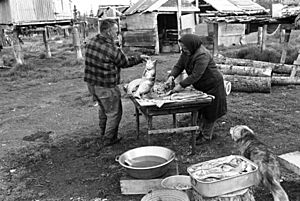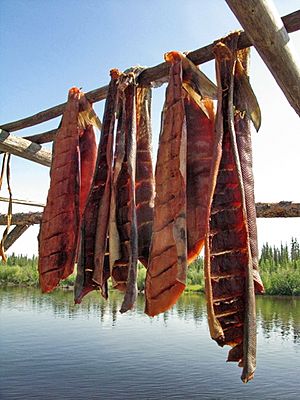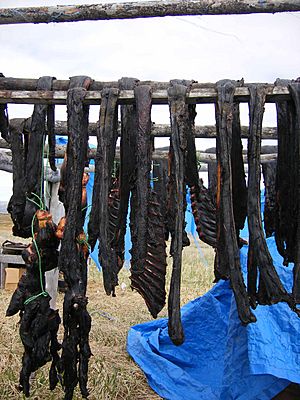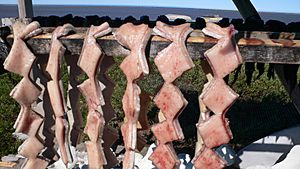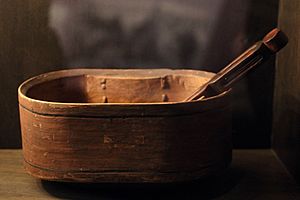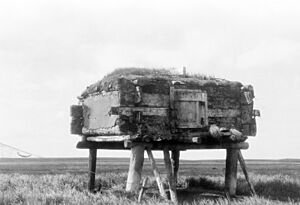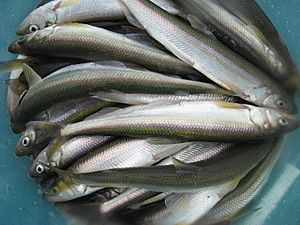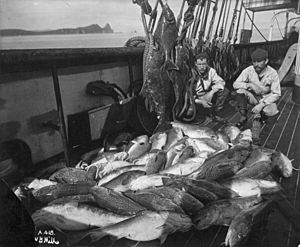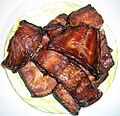Yup'ik cuisine facts for kids
The Yup'ik people, who live in western and southwestern Alaska, have a special way of eating called Yup'ik cuisine. In their language, it's called Yupiit neqait, which means "Yup'iks' foods" or "Yup'iks' fishes." This traditional way of eating is based on hunting, fishing, and gathering food from nature.
Yup'ik meals are mostly made from meat, including fish, birds, and animals from both the sea and land. These foods are packed with protein. Many people think these traditional foods are super healthy! The Yup'ik diet is different from other groups in Alaska, Canada, and Greenland. Fish, especially salmon and whitefish, are super important to the Yup'ik. Both "food" and "fish" are called neqa in their language.
People prepare food in many ways: they can ferment it, cook it, or eat it raw. Cooking methods include baking, roasting, barbecuing, frying, smoking, boiling, and steaming. To keep food fresh, they mostly dry it, and sometimes freeze it. Dried fish is often eaten with seal oil. A special fan-shaped knife called an ulu is used to cut fish and meat.
The Yup'ik people used to be semi-nomadic, meaning they moved around with the seasons to find food like fish, birds, sea and land animals, and berries. Their food comes from these traditional harvests. Areas near the coast rely more on sea animals like seals, walruses, and beluga whales, along with many kinds of fish and shellfish. Inland communities eat more salmon, whitefish, land animals like moose and caribou, birds, eggs, berries, and roots.
Some famous Yup'ik treats include akutaq (Eskimo ice cream), tepa (aged fish heads), and mangtak (muktuk). Today, about half of the food Yup'ik people eat comes from hunting and gathering, and the other half is bought from stores.
Contents
Yup'ik Food: A Taste of Alaska
The traditional food of the Yup'ik people, and also the Siberian Yupik and Iñupiaq people, is sometimes called "Eskimo cuisine" in Alaska. This ancient way of eating has been around for a very long time in North America, especially above the Arctic Circle. It started when the ancestors of the Iñupiaq and Yup'ik people traveled from Eastern Asia to Alaska many thousands of years ago during the last ice age. Because these cultures were so far away from others, their food traditions stayed strong and unchanged.
The Arctic diet is high in protein and doesn't include grains. Instead, it's filled with wild greens, roots, and berries. Experts say this diet is very healthy and balanced, providing lots of vitamins, minerals, proteins, and good fats from sea and land animals, fish, birds, and wild plants.
Yup'ik food preparation is unique. Even though different Yup'ik communities had different foods available, they all used similar ways to prepare and store food. This included air drying, smoking, storing food in cold water and oil, fermenting, and freezing. Some foods were even eaten raw. Long ago, Yup'ik people ate a mix of salmon, char, caribou, seals, and walruses.
What Meals Do Yup'ik People Eat?
The type of meal eaten by Yup'ik people can change based on customs and where they live.
- Breakfast (unuakutaq) is eaten an hour or two after waking up.
- Lunch or dinner (apiataq) is eaten around midday. This word comes from the Russian word for dinner.
- Supper or dinner (atakutaq) is eaten in the evening.
As one Yup'ik saying goes: "We eat breakfast at seven o'clock, lunch at twelve o'clock and dinner at six o'clock."
People from Nunivak Island often eat many times throughout the day. They might wake up very early, around 3 or 4 AM, especially if they need to catch fish like tomcod. Their first meal is eaten early, then another around 11 AM, with snacks in between. The evening meal is usually around 4:30 or 5 PM, with more snacks. In winter, meal times might shift later. A common food is dried or frozen fish dipped in seal oil. The evening meal is often a hot meal, like boiled fish with tea.
How Food is Prepared and Stored
Traditional Yup'ik food preparation includes eating raw food (Cassar- means "to eat raw flesh or meat"), fermenting, and cooking (keir-). In the past, Yup'ik people ate raw meat, including blood, and sometimes cooked meat.
Fish: A Main Dish
Fish is the most important food for Yup'ik people, especially Pacific salmon and whitefish. Both "food" and "fish" are called neqa in Yup'ik. Salmon is also called neqpik, meaning "real, genuine food." For the Iñupiaq people, whale and caribou meat are their main foods.
Salmon, herring, smelt, halibut, flounder, tomcod, pike, and capelin were cleaned and then air-dried or smoked. Fish heads were made into qamiqurrluk (cut and dried fish heads) or tepa (aged fish heads). Fish eggs were dried and stored.
Uncooked Fish Dishes
- Qassaq or Qassaulria is raw food, like raw flesh or meat.
- Quaq is meat or fish that is eaten raw and frozen.
- Nutaqaq is frozen raw fish.
- Qassayaaq or Qassayagaq (meaning "baby raw fish") is frozen raw whitefish that has been aged (fermented) before freezing and is served frozen.
- Kumlaciq is frozen meat (like fish or blackfish) eaten while still frozen. Freezing is a way to keep fish or meat fresh.
- Kumlaneq is frozen fish eaten while frozen. Chinook and coho salmon were often frozen. Chinook salmon were usually cut into smaller pieces, while smaller salmon like chum, sockeye, coho, and pink were often frozen whole.
- Kumlivirluuki means food stored in a freezer.
- Qercuqaq is hard-frozen fish, like blackfish.
Fermented fish is a traditional way to prepare fish.
- Ciss'uq is fermented herring or capelin that has been buried underground for two weeks.
- Tepcuaraq is fish that has been frozen after being allowed to age a little. It's eaten uncooked and frozen. The whole fish can be cleaned or left as is, then buried in a grass-lined pit for about a week to age. If caught in late fall, they are stored in a box until aged, then frozen. Tepcuaraq kumlaneq is eaten frozen with seal oil.
- Tepngayaaq is slightly fermented frozen fish.
- Tepa (meaning "odor" or "smell") is aged or fermented salmon fish heads. They are also called "stinkheads." Tepas were a special Yup'ik treat, mostly enjoyed by older Alaska Natives.
Traditionally, fish heads were buried in the ground, sometimes with fish guts, in wooden barrels or grass-lined pits. Salmon eggs and milt were added. The fermentation took one to two weeks, depending on the temperature. People described the taste as "sweet and sour." However, using plastic containers for this process can be dangerous because it can cause harmful bacteria to grow. The old, traditional methods allowed air to circulate, which prevented these bacteria from growing.
- Arumaarrluk is fish that is lightly smoked and stored in seal oil.
- Uqumaarrluk is fish that is slightly aged and stored in seal oil.
- Uqumelnguq is smoked fish soaked in seal oil.
Most dried and smoked salmon was eaten without further cooking, sometimes with seal oil.
- Niinamayak is partially dried, aged (fermented) herring.
- Cin'aq is a cheese-like fish aged in a pit, usually chum or king salmon. The whole salmon (without guts) is aged by burying it in a marshy, muddy area. The hole is dug until the frozen ground is reached, then lined with grass, moss, and cardboard. The salmon are placed inside, covered, and then the hole is filled with earth. The aged salmon is usually dug out in early winter and eaten as a special treat.
- Melucuaq or Elquaq is herring roe (eggs) attached to kelp or other underwater plants. This is a favorite food in many communities. People usually pick it by hand. Today, it's often frozen or salted, but in the past, it was dried and stored in grass baskets. It's usually eaten dipped in seal oil. This food is often shared with family and friends during celebrations.
- Imlaucuaq is herring sac roe. The sac-roe is dried into golden chips. It's stored in containers and can be soaked in water before eating, or eaten dried.
- Puyuqaq is smoked fish.
Cooked Fish Dishes
Cooking (kenir-) means preparing food with heat. Many methods are used:
- Roasting (maniar-)
- Barbecuing
- Baking (uute-)
- Frying (assali-, asgir-)
- Smoking (puyurte-, aruvarqi-, aruvir-)
- Boiling (ega-)
- Steaming (puyiar(ar)-)
- Keniraq is fresh cooked fish or other food, sometimes like a stew.
- Ugka is cooked fish or other food.
- Uuqnarliq is cooked blackfish.
- Allemaaq is cooked blackfish fry.
- Maniaq is fish roasted (barbecued) over an open fire. All parts of the fish except the guts are used. A stick is put through the fish and propped near the fire. A modern way is to wrap the fish in foil and cook it in a campfire.
- Teggsiq'er is half-dried herring, specifically made for cooking.
- Uutaq is baked fish.
- Salkuuyaq is fresh fish baked whole or filleted after the insides are removed. The fish is seasoned, oiled, and baked. Younger people often prefer this over plain boiled fish and eat it with boiled rice. This word comes from a Russian word for roast.
- Assaliaq is fresh fried fish. The fish is filleted, dipped in seasoned flour, or just salted, and fried in oil. Sometimes, the backbone or heads are fried too. Boiled rice is a popular side dish. This word also comes from a Russian word for frying.
- Egaaq is boiled fish or other food.
- Egamaarrluk is partially dried (not smoked) fish boiled for eating. It's only partly cooked.
- Qamangatak is half-dried, boiled fish.
- Umlikaaq or Ungllekaq is fresh boiled fish. Fresh fish that have been dead for less than a day are best because the meat is firm. The main ingredients are cut-up fish, water, and salt, boiled for about 20-30 minutes. Elders like this food because it's simple and not heavily seasoned. Fish heads are also good prepared this way.
- Qageq is day-old cooked blackfish, boiled and left to set in its cooled, jelled broth.
- Aagciuk is a fish meatball made from the soft meat and bones of spawned-out fish, cooked by dropping them into boiling water.
Mammals as Food
Sea mammals eaten include seals and beluga whales. Seals were the main marine mammal hunted. Seal oil (uquq) was used by most families. It's a source of healthy fats. Dried fish is often eaten with seal oil.
- Tangviaq is seal cracklings, which are crispy pieces left after oil has been taken from seal blubber.
- Civanraq is the leftover fibrous piece after seal oil is made by heating diced seal blubber.
- Cuakayak is cooked seal lung.
- Uqiquq is the practice of sharing bearded seal oil and meat when someone catches a seal.
Beluga whale meat is also eaten.
- Muktuk (mangtak) is a traditional Eskimo dish of frozen raw beluga whale skin with its fat attached.
- Aaqassaaq is beluga blubber for eating, or skin to be chewed to soften it.
- Taaqassaaq is skin for chewing. Walrus hide and flippers can be fermented to make this.
- Tamukassaaq is aged beluga skin.
- Kinengyak is dried meat, like caribou or moose. Dried moose meat was a favorite food for some communities.
- Qemitaq is muskrat or squirrel that has been hung by the neck to dry after being skinned.
Birds as Food
Almost all kinds of waterfowl (birds that live near water) were eaten, either fresh or dried, usually with oil or a sourdock leaf soup. Even cormorants, which taste fishy, were dried or boiled. Waterfowl eggs were sometimes eaten raw, but usually boiled. If there were too many eggs to eat at once, they were hard-boiled and stored in wooden dishes of seal oil for a short time.
Plants as Food
Berries and other edible plants added to meals that were mostly fish and game. Plants also provided important vitamins and nutrients. Berries were kept fresh by freezing. The most popular use for berries was in making akutaq, a whipped mixture of berries, sugar, and fat. Families also made jam, jellies, and breads from berries. Sourdock leaves were boiled like spinach. Labrador tea was boiled to make a drink, similar to regular tea. Green spruce needles were also used for tea.
Yup'ik people gathered green plants for food, medicine, and ceremonies. Women usually gathered these plants, often close to their villages or fish camps. Formal berry gathering activities also took place.
Mousefood (ugnaraat neqait) refers to the roots of tundra plants that voles store in their burrows. People would take a small part of the mouse's stored roots, sometimes replacing them with other food for the mouse. These tender green sprouts were often among the first fresh foods available and were eaten like a small salad.
Indigenous plants were a very important part of the Yup'ik diet all year round. Even though some people think Eskimo people only ate fish and meat, the Nunivak Cup'ig people used many local plants for food, medicine, and other purposes. Women and children traditionally gathered most plants while men hunted. Fresh spring greens were a welcome change from the winter diet of dried foods. Other greens were gathered as they ripened and eaten fresh or stored underground.
By late summer and early fall, many berry species and greens were ready to be picked. Women and children spent most days on the tundra gathering these plant resources. Many plants grew in different places, so families didn't always have to move to special camps just for plants. Some greens, like sour dock, were found all over the island. Old camp sites still have buried pits where plants were once stored.
Before storing "wild spinach" or sour dock in these pits, the cooked leaves were drained, and the pit was lined with woven grass mats. Berries were stored similarly, but these pits were lined with rocks. The berries would dry out while stored underground. In the fall, people would return to their seasonal storage pits and bring their stored berries and greens back to their winter village.
Pastry
- Bread (kelipaq) is a common food, with the word coming from the Russian word for bread. Other words for bread also exist.
- Flour (mukaaq) also comes from a Russian word.
- Fried bread (uqulek) is a popular dish, sometimes called "pancake" or "fry bread."
- Frybread (uqup'alek) is a homemade deep-fried biscuit, sometimes called "Eskimo doughnut" or "bannock" in Canada. It's similar to a doughnut or fried bannock. An Iñupiaq style Eskimo doughnut is a pretzel-like mix of seal oil, flour, and water, baked and fried in seal oil.
- Pilot bread or cracker (cugg'aliq) refers to a specific type of hard, unsalted cracker common in the North.
- Cookie (cugg'alinguaq)
- Easter bread (kulic'aaq) is Russian Orthodox Easter bread.
Drinks
In the past, Yup'ik people lived without hot drinks like tea or coffee, eating mainly fish.
- Tea (caayuq) is a common drink today, with the word coming from the Russian word for tea.
- Coffee (kuuvviaq) is also popular, with its name coming from the Russian word for coffee. Kuuvviapik means "real coffee."
Nutrition
Nutrition is about choosing and preparing foods so the body can use them for life and health. Alaska's traditional communities get a lot of healthy omega-3 fatty acids from their diet. However, adding more store-bought foods, which are often high in fats, carbs, and salt, can lead to weight gain, high cholesterol, high blood pressure, and long-term health problems. Eating more omega-3s can help reduce the risk of these issues. Yup'ik Eskimos have lower rates of type 2 diabetes compared to the rest of the U.S., even though they have similar levels of overweight and obesity. Older Yup'ik people show signs of a diet rich in traditional foods compared to younger people.
Tools
Food Storage
Dried and smoked salmon were usually kept in smokehouses, freezers, or special storage buildings called caches. Salted fish were stored in buckets or barrels inside homes or caches. Frozen salmon were kept in household freezers. Whole frozen coho salmon, used for dog food, were sometimes stored outside in pits.
An elevated cache, or raised log cache (qulvarvik), is a safe place to store food outdoors, designed to keep animals away. These caches can be made of logs or planks, or be open racks or platforms. High cabin-on-post caches might have been introduced by early traders or missionaries around the 1870s.
Dog Food
For thousands of years, dogs (qimugta) have been a big part of Yup'ik life, used for transportation as sled dogs and as companions. In the past, dogs were the only important domesticated animals.
Dog food (qimugcin) refers to food for dogs. Alunga is homemade dog food, a boiled mix of fish and meat. Salmon is the best food for dogs. Chum, coho, and pink salmon were often used for dog food. Besides dried salmon, whole uncut salmon, and parts like heads, guts, and backbones not used for human food, were also given to dogs. Chum salmon caught in August were usually dried for dog food. Coho salmon caught later in the fall were buried whole in earthen pits for dog food. Beluga whales, especially those hunted in late fall, were also used to feed dogs in some areas.
Food Sources
The Yup'ik people were hunter-fisher-gatherers, moving with the seasons to harvest fish, birds, sea and land animals, berries, and other natural resources. Subsistence, which means hunting, fishing, or gathering food to live on (not to sell), is practiced by almost all Yup'ik people. Inland Yup'ik villages primarily fish for red salmon and gather berries in the summer, and hunt caribou or moose in the fall and winter.
The Yup'ik region has many waterfowl, fish, and sea and land mammals. Coastal communities rely more on sea mammals like seals, walruses, and beluga whales, along with many types of fish, shellfish, crabs, and seaweed. Inland communities depend more on Pacific salmon and whitefish, land mammals like moose and caribou, migratory birds, bird eggs, berries, greens, and roots.
Many people believe traditional subsistence foods are healthier than store-bought foods. Wild salmon, game meat, and berries harvested by Alaska Natives are considered top-quality compared to processed, expensive items from stores. Hunting and gathering are also favored activities for many rural Alaskans, and are important for their culture and spirit.
In the Bristol Bay region and most of rural Alaska, salmon is the main subsistence food. Big game hunting for caribou and moose is important in inland areas, and marine mammal hunting is key in coastal areas.
The Alaska Department of Fish and Game (ADF&G) manages fish and wildlife resources in Alaska. The U.S. Fish and Wildlife Service also works to protect and improve fish and wildlife resources for the whole country.
Fish
Fish (neqa) is one of the most common Yup'ik foods.
- Pacific salmons (neqpik, meaning "real fish") are fish that lay their eggs in freshwater but live part of their lives in the ocean. Salmon is a very important food for Native Alaskans, and they traditionally use all parts of the fish.
- Red salmon or sockeye salmon (sayak)
- King salmon or Chinook salmon (taryaqvak)
- Silver salmon or coho salmon (qakiiyaq)
- Dog salmon or chum salmon (iqalluk) is the second-largest Alaskan salmon. It's called "dog salmon" because of its sharp teeth during spawning and how males bite each other. Some people think chum salmon are only good for dog food.
- Humpback salmon or pink salmon (amaqaayak)
- Rainbow trout or steelhead (talaariq) were usually cooked fresh and dried.
- Trout (charr) or Dolly Varden (iqallugpik) were usually cooked fresh and dried.
- Lake trout (cikignaq) were usually cooked fresh and dried.
- Sheefish or inconnu (ciiq) were dried, smoked, and frozen. They were also eaten fresh, boiled, or baked.
- Grayling (culugpauk) were usually cooked fresh and dried.
- Pike (cuukvak) were usually dried and eaten without further cooking. Sometimes they were cooked fresh.
- Blackfish or Alaska blackfish (can'giiq) were cooked by pouring boiling water into a pot with the fish and steaming them. They were one of the few fish not usually dried.
- Lush or burbot (manignaq) were dried and frozen. They were also boiled and baked.
- Herring (iqalluarpak) lay their eggs in sheltered bays. A large group of herring spawn in Bristol Bay. Herring and herring spawn-on-kelp have been harvested by local people for a very long time.
- Smelt or rainbow smelt (qusuuq) were cooked by frying and roasting when eaten fresh. Some fishermen considered them "emergency food" to be used if other food supplies ran out.
Sea Mammals
Marine mammals or sea mammals (imarpigmiutaq) include seals and walruses. Four types of seals in Alaska are called "ice seals" because they use sea ice for important parts of their lives, like having babies, nursing, and resting. These ice seals (ringed, bearded, spotted, and ribbon seals) are all used by coastal Alaska Natives for food, oil, materials, clothing, and crafts.
- Bearded seal (maklak) is the most well-known seal in Eskimo regions. Yup'ik hunters preferred bearded seals for their meat. The fat was made into oil.
- Ringed seal (nayiq), known as "winter seal," is the only seal generally available all winter. While bearded seals were preferred for meat, ringed seals were often chosen for their oil.
- Spotted seal and/or Harbor seal (issuriq)
- Ribbon seal (qasruliq) was hunted only sometimes. Its meat is rich in blood and not a favorite, but some hunters liked the oil.
- Steller's sea lion (uginaq) was not hunted often. Sea lions are most common near St. Lawrence Island.
- Walrus or Pacific walrus (asveq). Walrus hunting has been important for the native people of the Togiak area for over 2,500 years. Much of the walrus was used for food, including the hide, fat, muscle, flippers, head (including brains), and organs like the heart, liver, kidneys, and lungs.
- Beluga whale or white whale (cetuaq) is used for human and dog food. Beluga caught in spring are mainly for human food, while fall catches are more for dog food. Parts of the beluga used for human food include the skin, fat, backstrap, and intestines. Beluga skin is sometimes pickled. Beluga products are prepared in many ways, like boiling skin and meat, frying or barbecuing backstraps, and making fat into oil for dried fish and meat.
Land Mammals
Terrestrial mammals or land mammals (nunarmiutaq) include game animals and furbearers.
- Game animals (pitarkaq) include caribou, moose, and bears.
- Caribou or wild caribou (tuntu). Before Europeans arrived, caribou were important for their meat and skins, which were used for clothing. Caribou meat was often made into jerky. Almost all parts of the animal were used, including stomach contents like sedges.
- Reindeer or semi-domestic caribou (qusngiq). Reindeer were brought to Alaska 100 years ago and are raised for meat or antlers. They can mix with wild caribou. The Nunivak Island herd has about 4,000 reindeer.
- Moose or Alaska moose (tuntuvak, meaning "big caribou"). Moose meat was preserved by freezing and drying. Hunters would cut it into strips and hang it to dry in the sun, making jerky. Almost all of the moose was used. Bones were cracked for marrow. Fat was eaten uncooked. The head, feet, and hooves were also cooked. Moose was prepared in many ways, including boiling, roasting, stewing, frying, and in soups.
- Muskox (umingmar). Alaska's original muskox were hunted until they disappeared in the mid-1800s. In 1935–1936, 31 muskoxen were brought from Greenland to Nunivak Island to bring the species back and provide food for people.
- Brown bear (grizzly) (taqukaq) and Black bear (tan'gerliq) were hunted for their meat and fat. Bear meat was often dried into jerky. Internal organs like the heart, kidneys, and intestines were often given to elders. Bear meat was considered very tasty and was dried, boiled, baked, and roasted. The liver was generally not eaten.
- Furbearers (melqulek) are animals trapped for their fur and meat. The meat of most furbearers (beaver, mink, otter, muskrat, marten, lynx), except fox, wolf, and wolverine, was eaten by humans and also used as dog food.
- Red fox (kaviaq). Some people avoided eating red fox meat because they believed it would make them sleep during the day and be restless at night. This belief did not apply to white fox meat.
- Arctic fox (uliiq)
- Sea otter (arrnaq)
- Land otter or river otter (cuignilnguq)
- Mink (imarmiutaq). Mink skin parkas and pants were once made.
- Weasel or stoat (narullgiq)
- Marten (qavcicuaq)
- Muskrat (kanaqlak)
- Vole (avelngaq)
- Collared lemming (qilagmiutaq). Iñupiaq people do not eat lemmings.
- Brown lemming (pugultu)
- Beaver (paluqtaq)
- Porcupine (issaluuq) were harvested mainly for food and prepared similarly to hare.
- Tree squirrel or red squirrel (qiguiq)
- Ground squirrel or parka squirrel (qanganaq) were skinned and hung to dry on meat racks.
- Marmot or hoary marmot (cikigpak) were used similarly to parka squirrels.
- Hare (qayuqeggliq) and Rabbit (maqaruaq) can be prepared like poultry: roasted, broiled, grilled, fried, and stewed.
Birds
Birds (tengmiaq) are also a food source. Eggs from some species were collected. Waterfowl were prepared in various ways, such as boiling, baking, and in soups.
- Common eider or Pacific eider (metraq)
- King eider (qengallek)
- Steller's eider (anarnissakaq)
- Oldsquaw or long-tailed duck (allgiar(aq))
- Swan or tundra swan (qugyuk)
- Sandhill crane (qucillgaq)
- Ptarmigan were preserved by freezing or drying after being plucked or skinned. Dried birds were often eaten without further preparation, sometimes with seal oil. Ptarmigan were also boiled and used for soups.
- Common murre or common guillemot (alpa)
- Pigeon guillemot (ciguraq)
- Crested auklet (cip'lagar)
- Horned puffin (qilangaq)
- Black-legged kittiwake (naruyacuaq)
- Pelagic cormorant (uyalek)
- Snowy owl (anipa)
Plants
Berries and edible plants added to meals that were mostly fish and game. Plants also provided important vitamins and nutrients. Berries were kept fresh by freezing. The most popular use for berries was in making akutaq, a whipped mixture of berries, sugar, and fat. Families also made jam, jellies, and breads from berries. Sourdock leaves were boiled like spinach. Labrador tea was boiled to make a drink, similar to regular tea. Green spruce needles were also used for tea.
Mousefood (ugnaraat neqait) refers to the roots of tundra plants that voles store in their burrows. People would take a small part of the mouse's stored roots, sometimes replacing them with other food for the mouse. These tender green sprouts were often among the first fresh foods available and were eaten like a small salad.
Indigenous plants were a very important part of the Yup'ik diet all year round. Even though some people think Eskimo people only ate fish and meat, the Nunivak Cup'ig people used many local plants for food, medicine, and other purposes. Women and children traditionally gathered most plants while men hunted. Fresh spring greens were a welcome change from the winter diet of dried foods. Other greens were gathered as they ripened and eaten fresh or stored underground.
By late summer and early fall, many berry species and greens were ready to be picked. Women and children spent most days on the tundra gathering these plant resources. Many plants grew in different places, so families didn't always have to move to special camps just for plants. Some greens, like sour dock, were found all over the island. Old camp sites still have buried pits where plants were once stored.
Before storing "wild spinach" or sour dock in these pits, the cooked leaves were drained, and the pit was lined with woven grass mats. Berries were stored similarly, but these pits were lined with rocks. The berries would dry out while stored underground. In the fall, people would return to their seasonal storage pits and bring their stored berries and greens back to their winter village.
Images for kids


